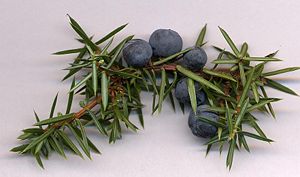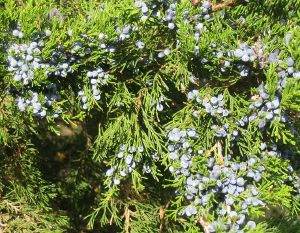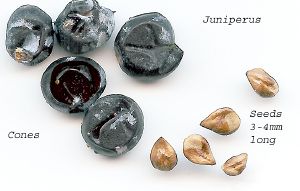Difference between revisions of "Juniper" - New World Encyclopedia
Rick Swarts (talk | contribs) |
Rick Swarts (talk | contribs) (→Uses) |
||
| Line 53: | Line 53: | ||
==Uses== | ==Uses== | ||
| − | Juniper berries are used for culinary and medicinal purposes, and the tree itself is used for lumber and aesthetic purposes. Juniper has had a long traditional use. Many of the earliest prehistoric people lived in or near juniper forests, which furnished them food, fuel, and wood for shelter or utensils, and juniper berries were used medicinally by the Ancient Egyptian doctors and by Native Americas (Wurges 2005). In addition to medical and culinary purposes, Native Americans have also used the seeds inside juniper berries as beads for [[ | + | Juniper berries are used for culinary and medicinal purposes, and the tree itself is used for lumber and aesthetic purposes. Juniper has had a long traditional use. Many of the earliest prehistoric people lived in or near juniper forests, which furnished them food, fuel, and wood for shelter or utensils, and juniper berries were used medicinally by the Ancient Egyptian doctors and by Native Americas (Wurges 2005). In addition to medical and culinary purposes, Native Americans have also used the seeds inside juniper berries as beads for [[jewelery]] and decoration (Moerman 1998). Juniper berries have been used as a popular flavoring agent for gin for more than 300 years (Wurges 2005). |
===Culinary uses=== | ===Culinary uses=== | ||
Revision as of 16:00, 20 November 2008
| Juniperus | ||||||||||||
|---|---|---|---|---|---|---|---|---|---|---|---|---|
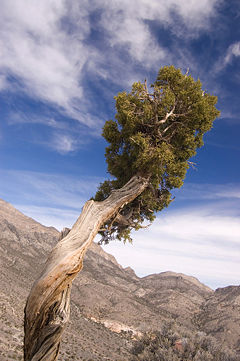 Juniperus osteosperma in Nevada
| ||||||||||||
| Scientific classification | ||||||||||||
| ||||||||||||
|
See text |
Juniper is the common name for any of various evergreen, coniferous trees or shrubs comprising the genus Juniperus of the cypress family Cupressaceae, characterized by needle-like and/or scale-like leaves (with the typically juvenile needle-like and mature scale-like leaves sometimes on the same tree) and the female cones having a small, round, fleshy, berry-like structure with hard-shelled seeds. Depending on taxonomic scheme, there are between 50 and 67 species of juniper, widely distributed throughout the northern hemisphere, from the Arctic, south to tropical Africa in the Old World, and to the mountains of Central America in the New World.
the berries, which are commonly blue or bluish-gray in color, but may be red-brown or orange, are used ..in flavoring in gin and in stuffing or sauces
.
Description
As conifers, division Pinophyta, junipers are cone-bearing seed plants (specifically gymnosperms) with vascular tissue.
Junipers vary in size and shape from tall trees, 20 to 40 meters (66-131 feet) tall, to columnar or low spreading shrubs with long trailing branches. They are evergreen with needle-like and/or scale-like leaves. They can be either monoecious or dioecious.
The female seed cones are very distinctive, with fleshy, fruit-like, coalescing scales that fuse together to form a "berry"-like structure, 4 to 28 millimeters (0.16-1.1 inches) long, with 1 to 12 unwinged, hard-shelled seeds. In some species these "berries" are red-brown or orange but in most they are blue; they are often aromatic. The seed maturation time varies between species from 6 to 18 months after pollination. The male cones are similar to those of other Cupressaceae, with 6-20 scales; most shed their pollen in early spring, but some species pollinate in the autumn.
Many junipers (e.g., J. chinensis, J. virginiana) have two types of leaves: seedlings and some twigs of older trees have long, needle-like leaves 5 to 25 millimeters (0.2-1 inches) long; and the leaves on mature plants are (mostly) tiny, 2 to 4 millimeters (0.08-0.16 inches) long, overlapping, flat, and scale-like. When juvenile foliage occurs on mature plants, it is most often found on shaded shoots, with adult foliage in full sunlight. Leaves on fast-growing "whip" shoots are often intermediate between juvenile and adult.
In some species (e.g. J. communis, J. squamata), all the foliage is of the juvenile needle-like type, with no scale leaves. In some of these (e.g. J. communis), the needles are jointed at the base, in others (e.g. J. squamata), the needles merge smoothly with the stem, not jointed.
The needle-leaves of junipers are hard and sharp, making the juvenile foliage very prickly to handle. This can be a valuable identification feature in seedlings, as the otherwise very similar juvenile foliage of cypresses (Cupressus, Chamaecyparis) and other related genera is soft and not prickly.
Juniper is the exclusive food plant of the larvae of some Lepidoptera species, including Bucculatrix inusitata and Juniper Carpet and is also eaten by the larvae of other Lepidoptera species such as Chionodes electella, Chionodes viduella, juniper pug (Eupithecia pusillata), and pine beauty (Panolis flammea).
Juniper berry
A juniper berry is the female seed cone produced by the various species of junipers. It is not a true berry but a cone with unusually fleshy and merged scales, which give it a berry-like appearance. The cones from a handful of species, especially Juniperus communis, are used as a spice, particularly in European cuisine, and also give gin its distinguishing flavor. All juniper species grow berries, but some are considered too bitter to eat. In addition to J. communis, other edible species include Juniperus drupacea (Farjon 2005), Juniperus oxycedrus (Adams 2004), Juniperus phoenicea (Dalby 2002), Juniperus deppeana, and Juniperus californica (Peattie and Landacre 1991). Some species, for example Juniperus sabina, are toxic and consumption is inadvisable (Grieve 1984).
Juniperus communis berries vary from four to twelve millimeters in diameter; other species are mostly similar in size, though some are larger, notably J. drupacea (20–28 mm). Unlike the separated and woody scales of a typical pine cone, those in a juniper berry remain fleshy and merge into a unified covering surrounding the seeds. The berries are green when young, and mature to a typically purple-black color over about 18 months in most species, including J. communis (shorter, 8–10 months in a few species, and about 24 months in J. drupacea) (farjon 2005). The mature, dark berries are usually but not exclusively used in cuisine, while gin is flavored with fully grown but immature green berries.
Uses
Juniper berries are used for culinary and medicinal purposes, and the tree itself is used for lumber and aesthetic purposes. Juniper has had a long traditional use. Many of the earliest prehistoric people lived in or near juniper forests, which furnished them food, fuel, and wood for shelter or utensils, and juniper berries were used medicinally by the Ancient Egyptian doctors and by Native Americas (Wurges 2005). In addition to medical and culinary purposes, Native Americans have also used the seeds inside juniper berries as beads for jewelery and decoration (Moerman 1998). Juniper berries have been used as a popular flavoring agent for gin for more than 300 years (Wurges 2005).
Culinary uses
The cones from a handful of juniiper species, especially Juniperus communis, are used as a spice, particularly in European cuisine, and also give gin its distinguishing flavor. According to one FAO document, juniper berries are the only spice derived from conifers (Ciesla 1998), though tar and inner bark (used as a sweetener by Apache cuisines) from pine trees is sometimes considered a spice as well.
Gin was developed in the 17th century in the Netherlands. It was first intended as a medication; juniper berries are a diuretic and were also thought to be an appetite stimulant and a remedy for rheumatism and arthritis. The name gin itself is derived from either the French genièvre or the Dutch jenever, which both mean "juniper" (Ciesla 1998). Other juniper-flavored beverages include the Finnish rye-and-juniper beer known as sahti, which is flavored with both juniper berries and branches (Jackson 1995).
Juniper berries are used in northern European and particularly Scandinavian cuisine to "impart a sharp, clear flavor" (Ciesla 1998) to meat dishes, especially wild birds (including thrush, blackbird, and woodcock) and game meats (including boar and venison) (Montagne 2003). They also season pork, cabbage, and sauerkraut dishes. Traditional recipes for choucroute garnie, an Alsatian dish of sauerkraut and meats, universally include juniper berries (Steingarten 1997). Besides Norwegian and Swedish dishes, juniper berries are also sometimes used in German, Austrian, Czech, and Hungarian cuisine, often with roasts.
A few North American juniper species produce a seed cone with a sweeter, less resinous flavor than those typically used as a spice. For example, one field guide describes the flesh of the berries of Juniperus californica as "dry, mealy, and fibrous but sweet and without resin cells" (Peattie and Landacre 1991). Such species have been used not just as a seasoning but as a nutritive food by some Native Americans (Moerman 1998).
Medicinal
Juniper berries are a spice used in a wide variety of culinary dishes and best known for the primary flavoring in gin (and responsible for gin's name, which is a shortening of the Dutch word for Juniper: genever). Juniper berries are also used as the primary flavor in the liquor Jenever and sahti-style of beers. Juniper berry sauce is often a popular flavoring choice for quail, pheasant, veal, rabbit, venison and other meat dishes.
Many species, such as J. chinensis (Chinese Juniper) from eastern Asia, are extensively used in landscaping and horticulture, and as one of the most popular species for use in bonsai. It is also a symbol of longevity, strength, athleticism, and fertility.
Some junipers are susceptible to Gymnosporangium rust disease, and can be a serious problem for those people growing apple trees, the alternate host of the disease.
Some juniper trees are misleadingly given the common name "cedar"— including the "red cedar" that is used widely in cedar drawers. True cedars are those tree species in the genus Cedrus, family Pinaceae.
Juniper berries have long been used as medicine by many cultures. Juniper berries act as a strong urinary tract disinfectant if consumed and were used by American Indians as a herbal remedy for urinary tract infections. Western tribes combined the berries of juniperus communis with Berberis root bark in a herbal tea to treat diabetes. Clinical studies have verified the effectiveness of this treatment in insulin-dependent diabetes. Compounds in these plants when combined and ingested have been shown to trigger insulin production in the body's fat cells, as well as stabilize blood sugar levels. Native Americans also used juniper berries as a female contraceptive. [1] The 17th Century herbalist physician Nicholas Culpeper recommended the ripened berries for conditions such as asthma and sciatica, as well as to speed childbirth. [2]
Uses
The flavour profile of young, green berries is dominated by pinene; as they mature this piney, resinous backdrop is joined by what McGee describes as "green-fresh" and citrus notes.[3] The outer scales of the berries are relatively flavourless, so the berries are almost always at least lightly crushed before being used as a spice. They are used both fresh and dried, but their flavour and odour is at their strongest immediately after harvest and decline during drying and storage.
An essential oil extracted from juniper berries is used in aromatherapy and perfumery.[4] The essential oil can be distilled out of berries which have already been used to flavour gin.[5]
History
Juniper berries have been found in ancient Egyptian tombs, including Juniperus phoenicia and Juniperus oxycedrus at multiple sites. The latter is not known to grow in Egypt, and neither is Juniperus excelsa, which was found along with J. oxycedrus in the tomb of Tutankhamun.[6] The berries imported into Egypt may have come from Greece; the Greeks record using juniper berries as a medicine long before mentioning their use in food.[7] The Greeks used the berries in many of their Olympics events because of their belief that the berries increased physical stamina in athletes.”[8] The Romans used juniper berries as a cheap domestically-produced substitute for the expensive black pepper and long pepper imported from India.[4] It was also used as an adulterant, as reported in Pliny the Elder's Natural History: "Pepper is adulterated with juniper berries, which have the property, to a marvellous degree, of assuming the pungency of pepper."[9] Pliny also incorrectly asserted that black pepper grew on trees that were "very similar in appearance to our junipers".
Classification
The number of juniper species is in dispute, with two recent studies giving very different totals, Farjon (2001) accepting 52 species, and Adams (2004) accepting 67 species. The junipers are divided into several sections, though (particularly among the scale-leaved species) which species belong to which sections is still far from clear, with research still on-going. The section Juniperus is an obvious monophyletic group though.
- Juniperus sect. Juniperus: Needle-leaf junipers. The adult leaves are needle-like, in whorls of three, and jointed at the base (see below right).
- Juniperus sect. Juniperus subsect. Juniperus: Cones with 3 separate seeds; needles with one stomatal band.
- Juniperus communis - Common Juniper
- Juniperus communis subsp. alpina - Alpine Juniper
- Juniperus conferta - Shore Juniper (syn. J. rigida var. conferta)
- Juniperus rigida - Temple Juniper or Needle Juniper
- Juniperus communis - Common Juniper
- Juniperus sect. Juniperus subsect. Oxycedrus: Cones with 3 separate seeds; needles with two stomatal bands.
- Juniperus brevifolia - Azores Juniper
- Juniperus cedrus - Canary Islands Juniper
- Juniperus deltoides - Eastern Prickly Juniper
- Juniperus formosana - Chinese Prickly Juniper
- Juniperus lutchuensis - Ryukyu Juniper
- Juniperus navicularis - Portuguese Prickly Juniper
- Juniperus oxycedrus - Western Prickly Juniper or Cade Juniper
- Juniperus macrocarpa (J. oxycedrus subsp. macrocarpa) - Large-berry Juniper
- Juniperus sect. Juniperus subsect. Caryocedrus: Cones with 3 seeds fused together; needles with two stomatal bands.
- Juniperus drupacea - Syrian Juniper
- Juniperus sect. Juniperus subsect. Juniperus: Cones with 3 separate seeds; needles with one stomatal band.
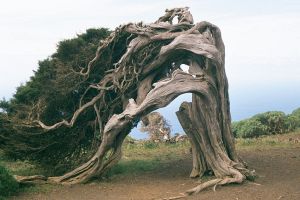
- Juniperus sect. Sabina: Scale-leaf junipers. The adult leaves are mostly scale-like, similar to those of Cupressus species, in opposite pairs or whorls of three, and the juvenile needle-like leaves are not jointed at the base (including in the few that have only needle-like leaves; see below right). Provisionally, all the other junipers are included here, though they form a paraphyletic group.
- Old World species
- Juniperus chinensis - Chinese Juniper
- Juniperus chinensis var. sargentii - Sargent's Juniper
- Juniperus convallium - Mekong Juniper
- Juniperus excelsa - Greek Juniper
- Juniperus polycarpos - Persian Juniper
- Juniperus foetidissima - Stinking Juniper
- Juniperus indica - Black Juniper
- Juniperus komarovii - Komarov's Juniper
- Juniperus phoenicea - Phoenicean Juniper
- Juniperus procera - East African Juniper
- Juniperus procumbens - Ibuki Juniper
- Juniperus pseudosabina - Xinjiang Juniper
- Juniperus recurva - Himalayan Juniper
- Juniperus recurva var. coxii - Cox's Juniper
- Juniperus sabina - Savin Juniper
- Juniperus sabina var. davurica - Daurian Juniper
- Juniperus saltuaria - Sichuan Juniper
- Juniperus semiglobosa - Russian Juniper
- Juniperus squamata - Flaky Juniper
- Juniperus thurifera - Spanish Juniper
- Juniperus tibetica - Tibetan Juniper
- Juniperus wallichiana - Himalayan Black Juniper
- Juniperus chinensis - Chinese Juniper
- New World species
- Juniperus angosturana - Mexican One-seed Juniper
- Juniperus ashei - Ashe Juniper
- Juniperus barbadensis - West Indies Juniper
- Juniperus bermudiana - Bermuda Juniper
- Juniperus blancoi - Blanco's Juniper
- Juniperus californica - California Juniper
- Juniperus coahuilensis - Coahuila Juniper
- Juniperus comitana - Comitán Juniper
- Juniperus deppeana - Alligator Juniper
- Juniperus durangensis - Durango Juniper
- Juniperus flaccida - Mexican Weeping Juniper
- Juniperus gamboana - Gamboa Juniper
- Juniperus horizontalis - Creeping Juniper
- Juniperus jaliscana - Jalisco Juniper
- Juniperus monosperma - One-seed Juniper
- Juniperus monticola - Mountain Juniper
- Juniperus occidentalis - Western Juniper
- Juniperus occidentalis subsp. australis - Sierra Juniper
- Juniperus osteosperma - Utah Juniper
- Juniperus pinchotii - Pinchot Juniper
- Juniperus saltillensis - Saltillo Juniper
- Juniperus scopulorum - Rocky Mountain Juniper
- Juniperus standleyi - Standley's Juniper
- Juniperus virginiana - Eastern Juniper (Eastern Redcedar)
- Juniperus virginiana subsp. silicicola - Southern Juniper
- Old World species
ReferencesISBN links support NWE through referral fees
- Adams, R. P. (2004). Junipers of the World: The genus Juniperus. Victoria: Trafford. ISBN 1-4120-4250-X
- Farjon, A. (2001). World Checklist and Bibliography of Conifers. Kew. ISBN 1-84246-025-0
- Farjon, A. (2005). Monograph of Cupressaceae and Sciadopitys. Royal Botanic Gardens, Kew. ISBN 1-84246-068-4
Cite error: Closing </ref> missing for <ref> tag
Wurges, in Longe.
External links
- Junipers of the world
- Gymnosperm Database - Juniperus
- Arboretum de Villardebelle Photos of cones and foliage of selected species
Credits
New World Encyclopedia writers and editors rewrote and completed the Wikipedia article in accordance with New World Encyclopedia standards. This article abides by terms of the Creative Commons CC-by-sa 3.0 License (CC-by-sa), which may be used and disseminated with proper attribution. Credit is due under the terms of this license that can reference both the New World Encyclopedia contributors and the selfless volunteer contributors of the Wikimedia Foundation. To cite this article click here for a list of acceptable citing formats.The history of earlier contributions by wikipedians is accessible to researchers here:
The history of this article since it was imported to New World Encyclopedia:
Note: Some restrictions may apply to use of individual images which are separately licensed.
- ↑ Edible and Medicinal Plants of the West, Gregory L. Tilford, ISBN 0-87842-359-1
- ↑ Culpeper's Complete Herbal, Nicholas Culpeper, ISBN 1-85007-026-1
- ↑ McGee, Harold (2004). On Food and Cooking (Revised Edition). Scribner, p. 410. ISBN 0-684-80001-2.
- ↑ 4.0 4.1 4.2 Dalby, A. (2002). Dangerous Tastes: The Story of Spices. University of California Press, p. 33. ISBN 0-520-23674-2.
- ↑ 5.0 5.1 Ciesla, William M (1998). Non-wood forest products from conifers. Food and Agriculture Organization of the United Nations. ISBN 92-5-104212-8. Chapter 8: Seeds, Fruits, and Cones. Retrieved July 27 2006.
- ↑ Manniche, Lisa (1999). Sacred Luxuries: Fragrance, Aromatherapy, and Cosmetics in Ancient Egypt. Cornell University Press, p. 21. ISBN 0-8014-3720-2.
- ↑ Dalby, Andrew (1997). Siren Feasts: A History of Food and Gastronomy in Greece. Routledge, p.142. ISBN 0-415-15657-2.
- ↑ James, Lorman. (1997) Greek Life. Gregory House: New York. 76-77.
- ↑ From Bostock and Riley's 1855 translation. Text online.
- ↑ Grieve, M. (1984). A Modern Herbal. Penguin. ISBN 0-14-046440-9.
- ↑ Jackson, Michael (1995). Sweating up a suitable thirst. Michael Jackson's Beer Hunter. Retrieved 30 July 2006.
- ↑ Adams, R. P. (2004). Junipers of the World: The genus Juniperus. Trafford. ISBN 1-4120-4250-X.
- ↑ Farjon, A. (2005). A Monograph of Cupressaceae and Sciadopityaceae. Royal Botanic Gardens, Kew, pp. 228-400. ISBN 1-84246-068-4.
- ↑ Peattie, Donald; Paul (1991). A Natural History of Western Trees. Houghton Mifflin Field Guides, p. 226. ISBN 0-395-58175-3.
- ↑ Steingarten, Jeffrey (1997). "True Choucroute", The Man Who Ate Everything. Vintage Books, p. 244. ISBN 0-375-70202-4. The chapter is an essay first published in 1989.
- ↑ Moerman, Daniel E (1998). Native American Ethnobotany. Timber Press, p. 282–290. ISBN 0-88192-453-9.
